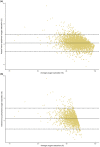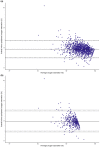The effect of patient ethnicity on the accuracy of peripheral pulse oximetry in patients with COVID-19 pneumonitis: a single-centre, retrospective analysis
- PMID: 34542168
- PMCID: PMC8653100
- DOI: 10.1111/anae.15581
The effect of patient ethnicity on the accuracy of peripheral pulse oximetry in patients with COVID-19 pneumonitis: a single-centre, retrospective analysis
Abstract
Pulse oximetry is used widely to titrate oxygen therapy and for triage in patients who are critically ill. However, there are concerns regarding the accuracy of pulse oximetry in patients with COVID-19 pneumonitis and in patients who have a greater degree of skin pigmentation. We aimed to determine the impact of patient ethnicity on the accuracy of peripheral pulse oximetry in patients who were critically ill with COVID-19 pneumonitis by conducting a retrospective observational study comparing paired measurements of arterial oxygen saturation measured by co-oximetry on arterial blood gas analysis (SaO2 ) and the corresponding peripheral oxygenation saturation measured by pulse oximetry (Sp O2 ). Bias was calculated as the mean difference between SaO2 and Sp O2 measurements and limits of agreement were calculated as bias ±1.96 SD. Data from 194 patients (135 White ethnic origin, 34 Asian ethnic origin, 19 Black ethnic origin and 6 other ethnic origin) were analysed consisting of 6216 paired SaO2 and Sp O2 measurements. Bias (limits of agreement) between SaO2 and Sp O2 measurements was 0.05% (-2.21-2.30). Patient ethnicity did not alter this to a clinically significant degree: 0.28% (1.79-2.35), -0.33% (-2.47-2.35) and -0.75% (-3.47-1.97) for patients of White, Asian and Black ethnic origin, respectively. In patients with COVID-19 pneumonitis, Sp O2 measurements showed a level of agreement with SaO2 values that was in line with previous work, and this was not affected by patient ethnicity.
Keywords: COVID-19 pneumonitis; critical care; ethnicity; pulse oximetry; skin pigmentation.
© 2021 Association of Anaesthetists.
Figures




Comment in
-
Variation in pulse oximetry readings: melanin, not ethnicity, is the appropriate variable to use when investigating bias.Anaesthesia. 2022 Mar;77(3):354-355. doi: 10.1111/anae.15620. Epub 2021 Nov 11. Anaesthesia. 2022. PMID: 34766336 No abstract available.
-
Racial discrepancies in oximetry: where do we stand?Anaesthesia. 2022 Feb;77(2):129-131. doi: 10.1111/anae.15635. Epub 2021 Nov 29. Anaesthesia. 2022. PMID: 34844284 No abstract available.
References
-
- US Food and Drug Administration . Pulse Oximeters ‐ Premarket Notification Submissions [510(k)s]: Guidance for Industry and Food and Drug Administration Staff. 2013. https://www.fda.gov/regulatory‐information/search‐fda‐guidance‐documents... (accessed 01/07/2021).
-
- Ebmeier SJ, Barker M, Bacon M, et al. A two centre observational study of simultaneous pulse oximetry and arterial oxygen saturation recordings in intensive care unit patients. Anaesthesia and Intensive Care 2018; 46: 297–303. - PubMed
Publication types
MeSH terms
LinkOut - more resources
Full Text Sources
Medical

